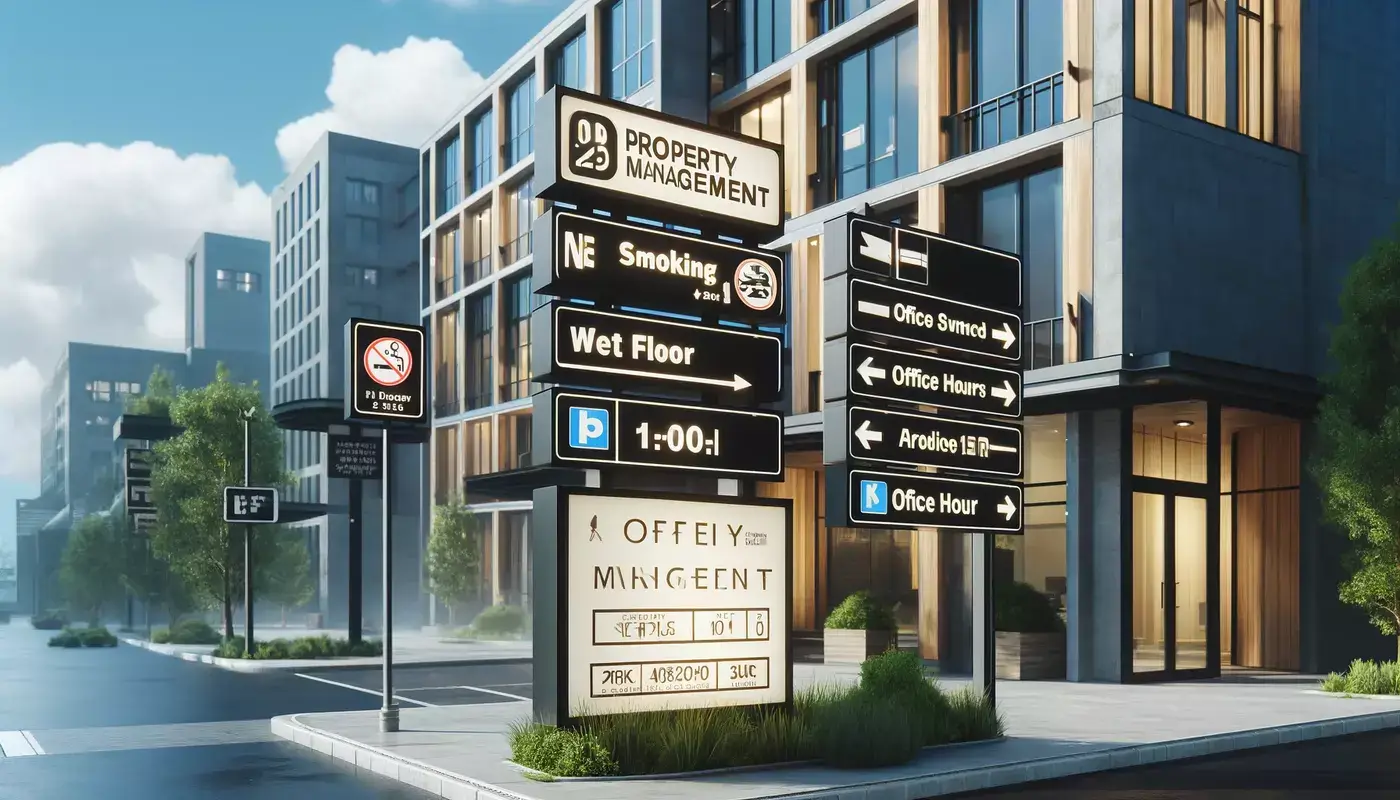Comprehensive Guide to Property Management Signs
Property management signs play a pivotal role in effectively managing residential and commercial properties. These signs provide critical information, enhance safety, and facilitate communication between property managers, tenants, and visitors. This article explores the diverse aspects of property management signs, from their types and significance to their design principles and technological advancements.

Table of Contents
- Overview of Property Management Signs
- Definition and Importance
- Historical Development
- Types of Property Management Signs
- Regulatory Signs
- Warning Signs
- Informational Signs
- Directional Signs
- Materials Used in Property Management Signs
- Traditional Materials
- Modern Innovations
- Design Principles of Property Management Signs
- Visibility and Legibility
- Color Schemes
- Symbolism and Icons
- Technological Advancements in Property Management Signs
- Digital Signage
- Reflective and LED Signs
- Regulatory Standards and Compliance
- International Standards
- Regional Regulations
- Role of Property Management Signs in Safety
- Reducing Accidents
- Enhancing Tenant and Visitor Awareness
- Property Management Signs for Advertising
- Entrance Signs
- Window Graphics
- Billboards
- Environmental Impact and Sustainability
- Eco-friendly Materials
- Recycling and Disposal
- Case Studies and Real-life Examples
- Successful Implementations
- Lessons Learned
- Future Trends in Property Management Signage
- Smart Signs
- Integration with IoT
- FAQs
- Common Questions Answered
1. Overview of Property Management Signs
Definition and Importance
Property management signs are visual aids used to convey information, ensure safety, and facilitate communication within residential and commercial properties. These signs are vital for maintaining order, guiding tenants and visitors, and providing essential information efficiently.
Property management signs serve several critical purposes:
- Safety: They alert tenants and visitors to potential hazards, such as wet floors, fire exits, and emergency evacuation routes.
- Information: They provide essential details about property amenities, office hours, parking regulations, and more.
- Navigation: They help tenants and visitors find their way around the property with directional signs to exits, parking areas, and specific buildings.
Historical Development
The use of property management signs dates back to ancient civilizations where signs were used to mark boundaries and convey important information. Over time, the materials, designs, and technologies used in property management signs have evolved significantly, adapting to modern needs and advancements in property management practices.
In the early 20th century, the growth of urban areas and the construction of large residential and commercial buildings increased the demand for standardized signage. This period saw the introduction of more durable materials and the development of regulatory standards to ensure the effectiveness and safety of property management signs.
2. Types of Property Management Signs
Regulatory Signs
Regulatory signs enforce property rules and regulations. Examples include:
- No Smoking: Indicates areas where smoking is prohibited.
- No Trespassing: Warns against unauthorized entry.
- Fire Lane: Marks areas where parking is prohibited to allow access for emergency vehicles.
These signs are crucial for maintaining order and ensuring compliance with property policies.
Warning Signs
Warning signs alert tenants and visitors to potential hazards. Common examples include:
- Wet Floor: Indicates areas that are slippery when wet.
- Construction Zone: Warns of ongoing construction work.
- Restricted Area: Marks areas that are off-limits to unauthorized personnel.
These signs play a vital role in preventing accidents and ensuring safety within the property.
Informational Signs
Informational signs provide useful data, such as:
- Office Hours: Displays the operating hours of property management offices.
- Property Maps: Helps tenants and visitors navigate the property.
- Amenity Locations: Indicates the location of facilities like gyms, pools, and laundry rooms.
They help tenants and visitors navigate the property and access services easily.
Directional Signs
Directional signs guide tenants and visitors to specific locations. Examples include:
- Exit Signs: Indicate the location of exits.
- Parking Signs: Direct drivers to parking areas.
- Elevator Signs: Point to the nearest elevators.
These signs are essential for efficient navigation within the property.
3. Materials Used in Property Management Signs
Traditional Materials
Historically, property management signs were made from materials like wood and metal. While durable, these materials had limitations in terms of visibility and longevity. Metal signs were prone to rust and corrosion, while wooden signs could warp and deteriorate over time.
Modern Innovations
Today, property management signs are made from advanced materials like high-density polyethylene (HDPE), aluminum, and reflective sheeting. These materials offer several advantages:
- HDPE: Resistant to weathering, lightweight, and durable.
- Aluminum: Corrosion-resistant, strong, and long-lasting.
- Reflective Sheeting: Enhances visibility, especially in low-light conditions.
These innovations ensure that property management signs are more effective and durable in various environmental conditions.
4. Design Principles of Property Management Signs
Visibility and Legibility
Effective property management signs must be easily visible and legible from a distance. Key considerations include:
- Font Size: Large enough to be read from a distance.
- Contrast: High contrast between text and background for better readability.
- Placement: Positioned at eye level and in well-lit areas.
Ensuring that signs can be read quickly and easily is critical for their effectiveness.
Color Schemes
Colors play a crucial role in sign design. Standard color codes help ensure quick recognition and understanding:
- Red: Indicates danger or prohibitions (e.g., no smoking).
- Yellow: Warns of potential hazards (e.g., wet floor).
- Green: Indicates safe conditions or directions (e.g., exit).
Using the right color combinations enhances the visibility and comprehension of the signs.
Symbolism and Icons
Using universally recognized symbols and icons on signs helps overcome language barriers and ensures clear communication. Examples include:
- Fire Exit: A running figure and an arrow.
- No Smoking: A cigarette with a red line through it.
- Wheelchair Access: A wheelchair icon.
Symbols are often easier to understand quickly, which is essential for tenants and visitors who need to make rapid decisions.
5. Technological Advancements in Property Management Signs
Digital Signage
Digital signs offer dynamic content that can be updated in real-time, providing timely information and enhancing tenant and visitor awareness. These signs are particularly useful in areas with frequently changing conditions, such as event schedules or maintenance updates.
Reflective and LED Signs
Reflective materials and LED lights improve sign visibility, especially in low-light conditions. These advancements ensure that property management signs remain effective at all times, enhancing overall safety and communication.
6. Regulatory Standards and Compliance
International Standards
Organizations like the International Organization for Standardization (ISO) set global standards for property management signs, ensuring consistency and safety across different regions. These standards help create a uniform system that can be relied upon worldwide.
Regional Regulations
Different regions have specific regulations governing the design, placement, and maintenance of property management signs. Adhering to these regulations is crucial for ensuring that signs are effective and compliant with local laws.
7. Role of Property Management Signs in Safety
Reducing Accidents
Properly designed and placed property management signs can significantly reduce the risk of accidents by providing clear and timely information to tenants and visitors. Signs that warn of hazards or enforce property rules help prevent injuries and other incidents.
Enhancing Tenant and Visitor Awareness
Property management signs keep tenants and visitors informed about rules, conditions, and changes, helping them make better decisions. By staying aware of their surroundings, individuals can navigate more safely and efficiently.
8. Property Management Signs for Advertising
Entrance Signs
Entrance signs are the first point of contact for visitors and tenants. These signs often feature property branding and important information, making a strong first impression and providing essential details.
Window Graphics
Window graphics are used to display promotional messages, property information, and branding on windows. These graphics are eye-catching and can effectively communicate with both tenants and passersby.
Billboards
Billboards placed strategically within or near properties can be used for advertising services, events, and special offers. They attract attention and convey messages to a wide audience.
9. Environmental Impact and Sustainability
Eco-friendly Materials
The use of sustainable materials, such as recyclable plastics and environmentally friendly inks, reduces the environmental impact of property management signs. Choosing eco-friendly options helps protect the environment while maintaining the effectiveness of the signage.
Recycling and Disposal
Proper recycling and disposal of old signs help minimize waste and environmental pollution. Implementing recycling programs for outdated or damaged signs ensures that materials are reused and do not contribute to landfill waste.
10. Case Studies and Real-life Examples
Successful Implementations
Examining successful implementations of property management signage can provide valuable insights into best practices and innovative approaches. Real-life examples highlight the effectiveness of well-designed signs in various contexts.
Lessons Learned
Learning from past experiences, both successes and failures, can guide future projects and improve outcomes. Analyzing case studies helps identify common challenges and effective solutions.
11. Future Trends in Property Management Signage
Smart Signs
Smart signs equipped with sensors and connectivity features can provide real-time information and adapt to changing conditions. These signs represent the future of property management signage, offering enhanced functionality and responsiveness.
Integration with IoT
As the Internet of Things (IoT) becomes more prevalent, property management signs will need to evolve to communicate effectively with these systems. Integrating signage with IoT technologies ensures that properties can manage and convey information efficiently.
12. FAQs
Common Questions Answered
Q: What materials are best for property management sign? A: Modern property management signs are typically made from materials like high-density polyethylene (HDPE), aluminum, and reflective sheeting for durability and visibility.
Q: How do property management signs enhance safety? A: Property management signs enhance safety by providing clear, timely information that helps tenants and visitors make informed decisions and avoid hazards.
Q: What are the latest trends in property management signage? A: The latest trends include the use of smart signs with real-time updates, integration with IoT technologies, and the use of eco-friendly materials.
Q: How are property management signs used in advertising? A: Property management signs are used in advertising through entrance signs, window graphics, and billboards. They help promote services, events, and special offers to tenants and visitors.
Q: What are the types of property management sign? A: The types of property management signs include regulatory signs, warning signs, informational signs, and directional signs.
Q: What role do colors play in property management sign? A: Colors are crucial for quick recognition and understanding. Standard color codes, like red for danger and green for safety, ensure that tenants and visitors can easily comprehend the signs.
Q: What are the environmental considerations for property management sign? A: Environmental considerations include using eco-friendly materials and ensuring proper recycling and disposal of old signs to minimize waste and pollution.
Q: How do digital signs benefit property management? A: Digital signs provide dynamic, real-time updates that enhance tenant and visitor awareness and adaptability to changing conditions, improving overall property management.
Q: What is the importance of regulatory compliance for property management signs? A: Regulatory compliance ensures that signs are effective and safe, adhering to international and regional standards that maintain consistency and reliability.
Q: What is the impact of property management signs on tenant and visitor behavior? A: Property management signs influence tenant and visitor behavior by providing necessary information and warnings, helping them make safer and more informed decisions.
